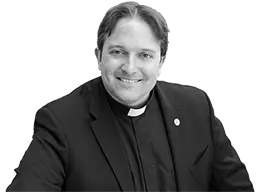 Fr Matthew Charlesworth SJJesuit PriestSociety of JesusJesuit priest working in Southern AfricaFr. MatthewCharlesworthSJ
Fr Matthew Charlesworth SJJesuit PriestSociety of JesusJesuit priest working in Southern AfricaFr. MatthewCharlesworthSJ
 Thursday of the 5th Week of Lent
Thursday of the 5th Week of Lent
Date: | Season: Lent | Year: C
First Reading: Genesis 17:3–9
Responsorial Psalm: Psalm 105:4–9
| Response: Psalm 105:8a
Gospel Acclamation: Psalm 95:8
Gospel Reading: John 8:51–59
Preached at: the Chapel of the Most Holy Name, Kolvenbach House in the Archdiocese of Lusaka, Zambia.
“Since once again, Lord, I have neither bread nor wine nor altar, I will raise myself beyond these symbols… and will consecrate the world to you.” —Pierre Teilhard de Chardin, The Divine Milieu
Today, we quietly remember the passing of Pierre Teilhard de Chardin, SJ, who died on this day in 1955, after years of exile, research, silence, and prayer. A Jesuit, a paleontologist, and a mystic, Teilhard’s life was marked by a deep search for God—not outside of creation, but within it. For him, faith and science were not rivals. They were twin languages pointing to a single mystery: Christ at the heart of all things, drawing the universe into fullness.
His life and vision open a door for us to reflect more deeply on the scriptures we hear today—on the nature of promise, presence, and God’s unfolding work in the world.
We begin with Genesis: “I will maintain my covenant with you and your descendants after you throughout the ages…”
This is not a private promise. It’s cosmic. Abraham is invited to trust a God he cannot see, to believe in fruitfulness even when his body says otherwise, to step into a future not yet visible. It’s a covenant grounded not in certainty, but in faithful relationship.
Then in the Psalm, we’re told: “The Lord remembers his covenant forever.” The psalmist reminds us that God’s promises are not passing. They are patient. God’s faithfulness runs through the long arc of history—from wilderness wanderings to exile, from Genesis to the Gospel.
And finally, in John’s Gospel, Jesus says the astonishing words: “Before Abraham was, I AM.”
These are not just theological fireworks. These are the words of One who claims identity with the Living God—the same “I AM” who spoke to Moses from the burning bush. Jesus doesn’t just point to God’s promises. He is their fulfillment. He is Presence itself, standing in their midst, unrecognized.
This is the kind of vision that Teilhard spent his life exploring—not simply in books or ideas, but in fieldwork, in fossils, in the slow unfolding of the Earth’s story. He believed that God’s covenant with creation was not static or abstract, but dynamic—that all of creation is being drawn, slowly and mysteriously, toward unity in Christ. He saw the Incarnation not as a divine interruption, but as the deep logic of creation itself.
For Teilhard, the universe is not winding down into entropy; it is being drawn upward, inward, forward—toward the One who said “I AM”.
And so, on this quiet weekday in Lent, we might pause and ask: Do we believe this? Do we live as if this covenant is still alive, still active, still drawing us toward something—Someone—greater?
Teilhard once wrote:
“The day will come when, after harnessing space, the winds, the tides, and gravitation, we shall harness for God the energies of love. And on that day, for the second time in the history of the world, we will have discovered fire.”
That fire is what burned in the bush that Moses saw. That fire is what Jesus bore in His very being when He declared “I AM.” And that fire, Teilhard believed, is the hidden flame within all things—longing to be revealed.
So we return to this altar. And we bring bread, wine, prayer, and desire. We bring our part of the world to be consecrated— just as Teilhard did, even when he had no altar.
And as we do, we allow Christ—who is before Abraham, and after Teilhard, and present here—to draw us deeper into His covenant of love.
Let us now pause with these three questions for our personal prayer:
- Where am I being invited—like Abraham—to trust God’s promise without knowing the outcome?
- Where do I sense Christ’s presence in the ordinary moments of my day—in nature, in conversation, in struggle, in beauty?
- How might I live more consciously in Christ’s covenant, letting myself be drawn—like Teilhard imagined—toward love at the heart of all things?
Amen.
In preparing this homily, I consulted various resources to deepen my understanding of today’s readings, including using Magisterium AI for assistance. The final content remains the responsibility of the author.
← Back